Over the course of a few years, I’ll tie different strands that I research together. I use LORE as a term for this package of research; LORE in the sense of “folklore” but also as “body of traditions” or (in)visible cultural norms we abide by. First, because everything I do places itself in storytelling. Also, because I live and die for a good faerytale. And lastly, because I was invited by an indigenous elder to learn with her. In Wirradjirri, the indigenous Australian Dreaming is referred to as LAW/LORE, which opened up a whole new way of thinking about culture and ethics as a way to “law”. The different strands that I collect under LORE are emerging as I evolve. The first theme that came to me was Androgyny, or generally everything that’s in-between.
 To get my ethnography going I started a facebook group to start a conversation about the “in between” across many domains: sex (on being both masc/fem as male/female), politics (on binaries and unity), creativity (on being ambidextrous), mind (on reasoning and sensing), culture (on science and art), philosophy (on spirituality and logic). It’s about integration and remix and what it means when it gets jumbled in a body; how it (re)presents itself in the world; and about our agency. Something important is shifting globally and here’s a forum to move beyond binaries.
To get my ethnography going I started a facebook group to start a conversation about the “in between” across many domains: sex (on being both masc/fem as male/female), politics (on binaries and unity), creativity (on being ambidextrous), mind (on reasoning and sensing), culture (on science and art), philosophy (on spirituality and logic). It’s about integration and remix and what it means when it gets jumbled in a body; how it (re)presents itself in the world; and about our agency. Something important is shifting globally and here’s a forum to move beyond binaries.
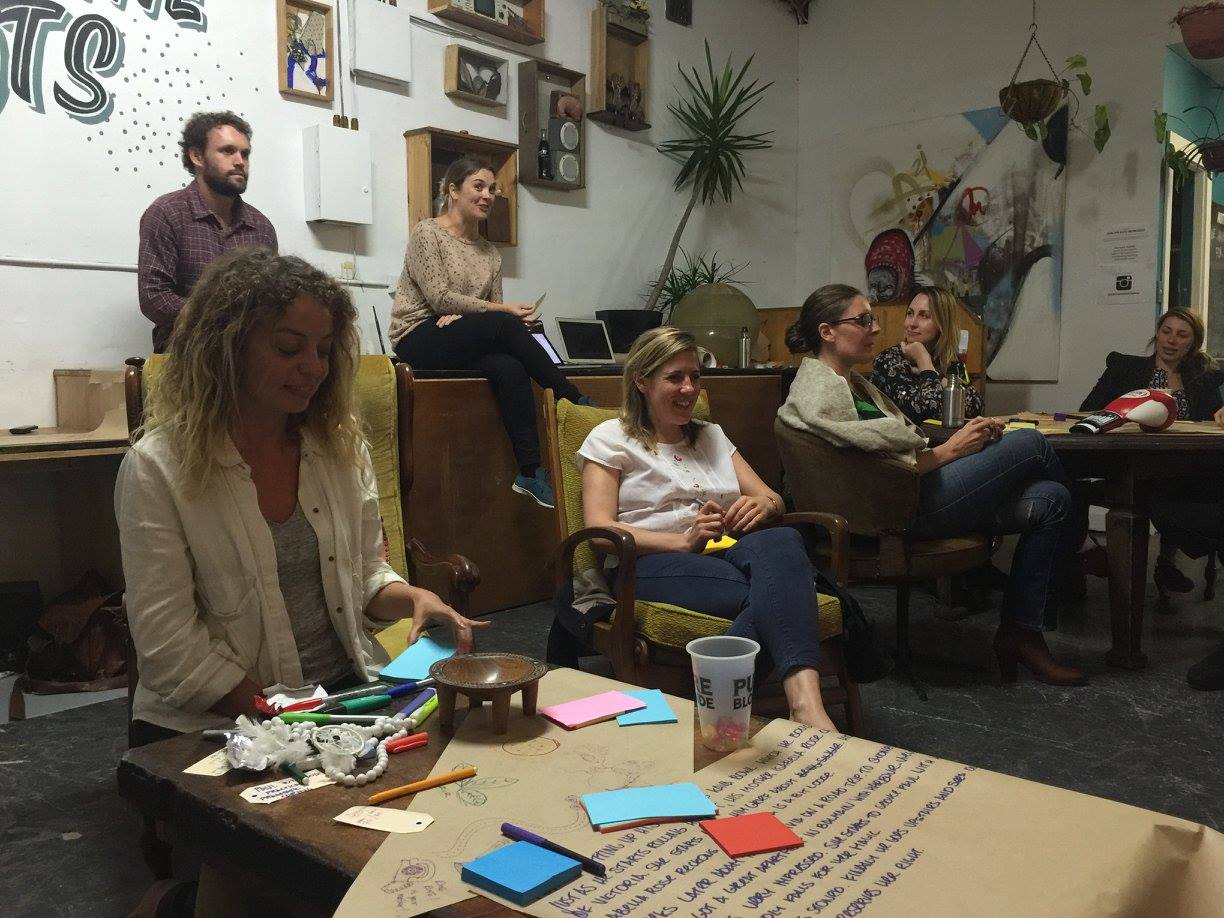 Soon after I had about 300 group members, I invited those based in Sydney to a local workshop, a playground to explore and make-do. We were about 20, meeting for 3h at Join the Dots, a workshop space in Marrickville. We had queers, cis, mums, dads, singles, Europeans, Australians, freelancers, artists, consultants, yoga teachers, designers, employees, entrepreneurs, writers, musicians, academics, artists, oh dear so many, all between the age of 5 to 50.
Soon after I had about 300 group members, I invited those based in Sydney to a local workshop, a playground to explore and make-do. We were about 20, meeting for 3h at Join the Dots, a workshop space in Marrickville. We had queers, cis, mums, dads, singles, Europeans, Australians, freelancers, artists, consultants, yoga teachers, designers, employees, entrepreneurs, writers, musicians, academics, artists, oh dear so many, all between the age of 5 to 50.
The main questions we asked when designing this playground were:
– How can we soften current labels around gender, queerness or heteronormativity?
– How can we soften ubiquitous divisive/competitive language (i.e in Business and Science) to a more androgynous/integrative one?
– How can we play in between binaries and make people comfortable with that fuzziness?
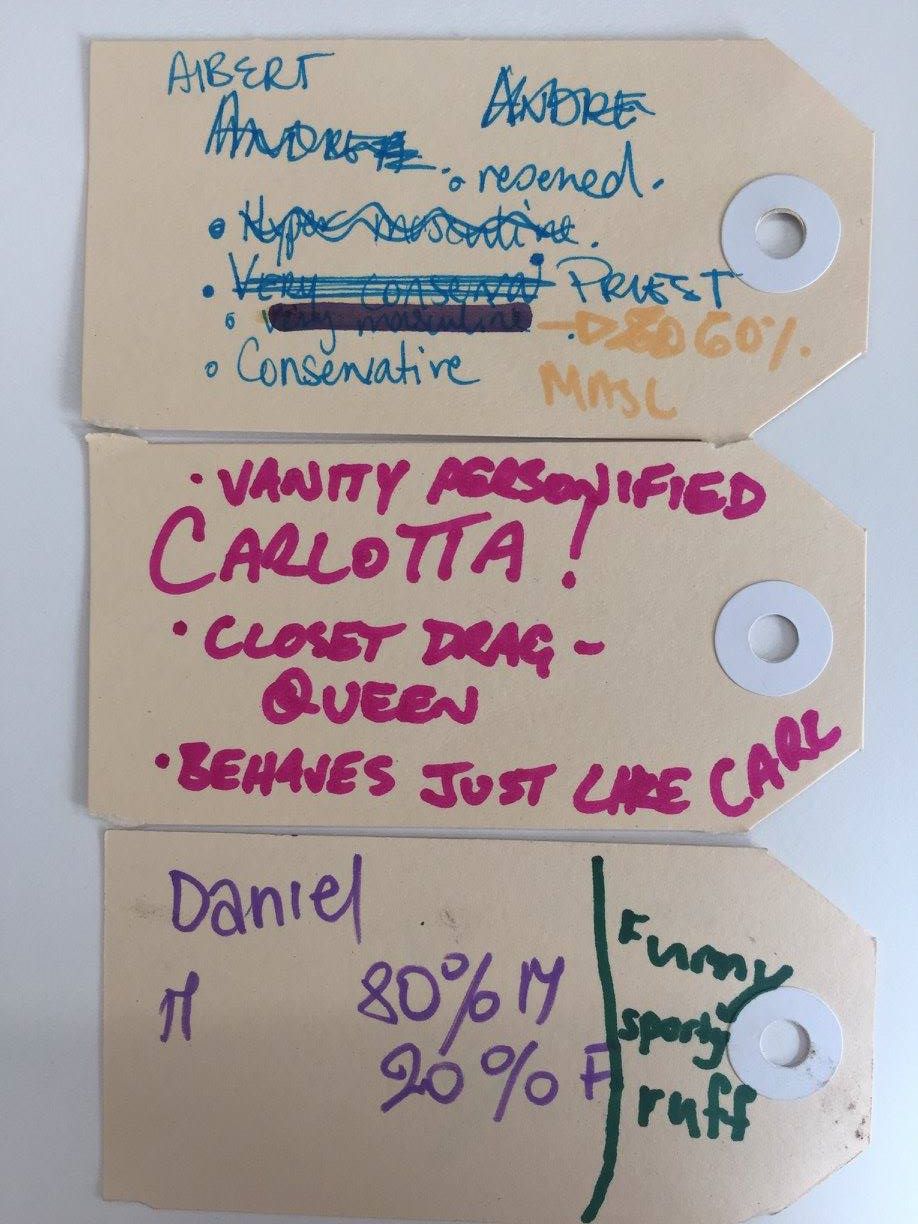 We started with a little identity change. We gave each participant a small tag. On the one side they first estimated their percentage of feminine and masculine traits. For example, today I feel 70% feminine and 30% masculine in a female body. Then, we turned the tag around and wrote on the other side. This time, we would choose the opposite or a variation that is very alien to me. For example, I would now have a male body and feel 90% and 10% feminine. The idea was to tap into empathy. Once we had our characters, we all pledged to stay in character throughout the workshop. When we did this, Baran played the hang for us. The atmosphere was so joyful, chilled and energised. Loved it.
We started with a little identity change. We gave each participant a small tag. On the one side they first estimated their percentage of feminine and masculine traits. For example, today I feel 70% feminine and 30% masculine in a female body. Then, we turned the tag around and wrote on the other side. This time, we would choose the opposite or a variation that is very alien to me. For example, I would now have a male body and feel 90% and 10% feminine. The idea was to tap into empathy. Once we had our characters, we all pledged to stay in character throughout the workshop. When we did this, Baran played the hang for us. The atmosphere was so joyful, chilled and energised. Loved it.
Before the workshop we had asked everyone to bring three objects, ne that is masculine, one feminine and one neutral. We laid out a large butcher paper and everyone traced their object and took it away again. 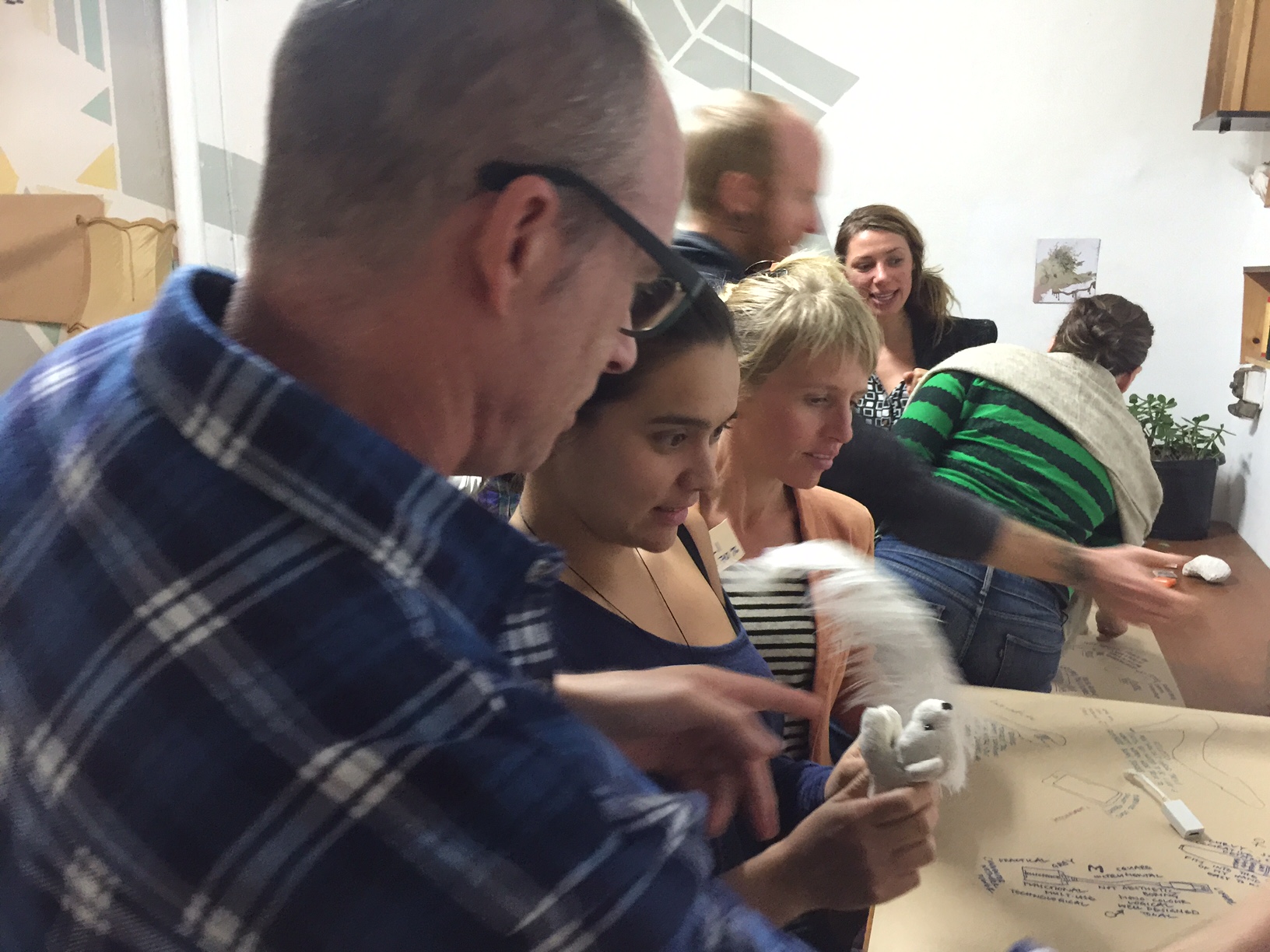 Just looking at the outlines, the group walked around and wrote adjectives next to the traces. This way, we collected impressions about shapes and outlines that hint on masculine and feminine, but we also gathered counterintuitive statements. Overall, we figured that objects were divided into fem, neutral or masc according to their function and/or shape. Very interesting was the 5-year-old, who couldn’t identify specific female objects, everything was male or neutral. Overall, we saw that everyone started from a different idea of what Androgyny is.
Just looking at the outlines, the group walked around and wrote adjectives next to the traces. This way, we collected impressions about shapes and outlines that hint on masculine and feminine, but we also gathered counterintuitive statements. Overall, we figured that objects were divided into fem, neutral or masc according to their function and/or shape. Very interesting was the 5-year-old, who couldn’t identify specific female objects, everything was male or neutral. Overall, we saw that everyone started from a different idea of what Androgyny is.
 To go into the next exercise we asked everyone to choose an object and form groups around a certain object. The task was to create a story that incorporates the object and the gender swapped characters we were playing. For the next hour, groups drew story boards, build small objects and wrote various versions of character development. All this work was done on butchers paper.
To go into the next exercise we asked everyone to choose an object and form groups around a certain object. The task was to create a story that incorporates the object and the gender swapped characters we were playing. For the next hour, groups drew story boards, build small objects and wrote various versions of character development. All this work was done on butchers paper.
 To share their ideas, each group improvised a 5-minute performance with everyone on stage performing their character in drag. Giving everyone a counterintuitive role, our idea was to help people get into other people’s shoes. But what happened instead was that all our stories poised at the edge of stereotyping. It was remarkable to see how we all exposed ourselves freely to how little we actually knew about what it really felt like for others.
To share their ideas, each group improvised a 5-minute performance with everyone on stage performing their character in drag. Giving everyone a counterintuitive role, our idea was to help people get into other people’s shoes. But what happened instead was that all our stories poised at the edge of stereotyping. It was remarkable to see how we all exposed ourselves freely to how little we actually knew about what it really felt like for others.
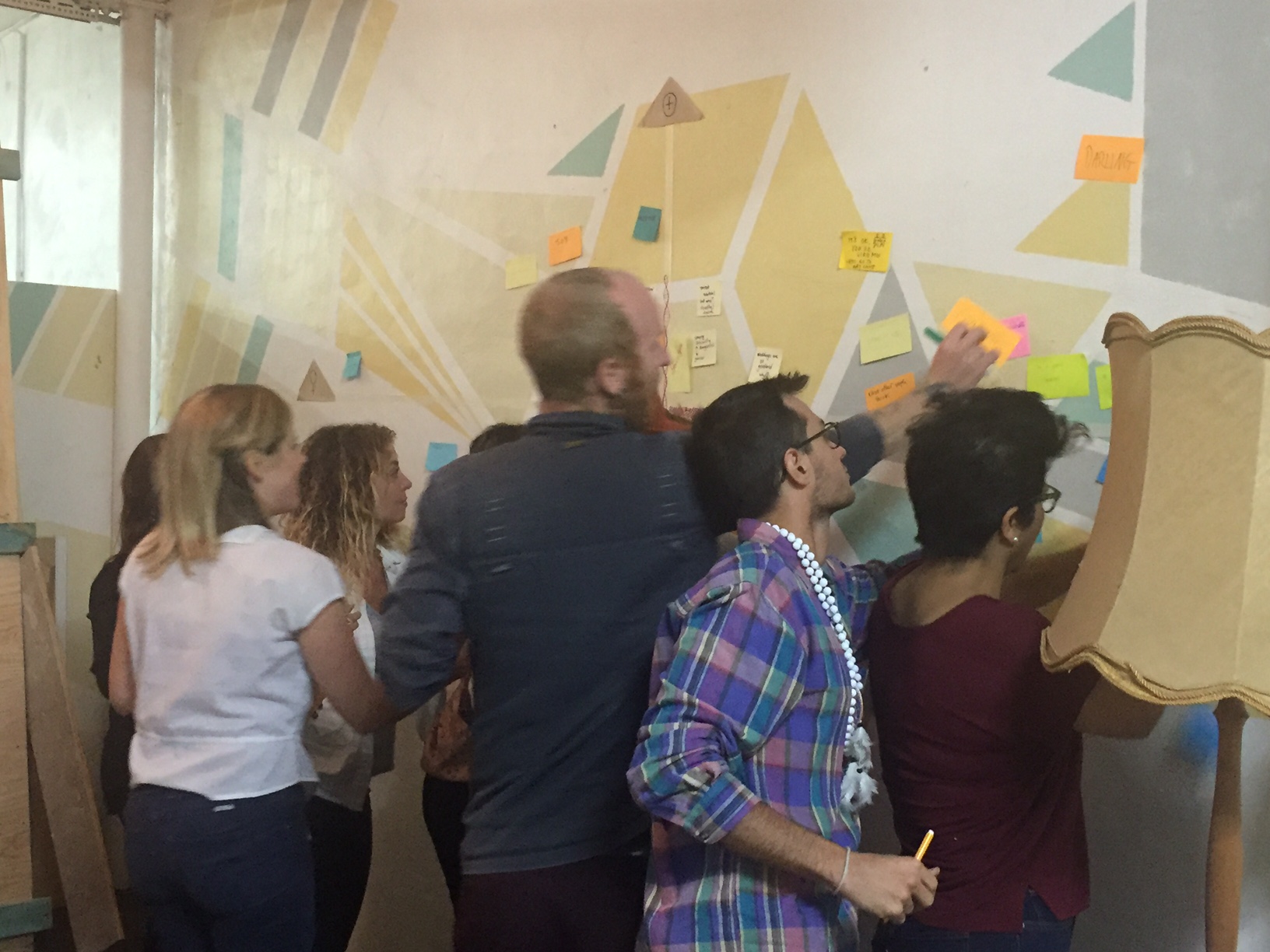 While listening to the stories, the audience would make notes on “Triggers and Thresholds”. Whenever they were triggered emotionally by something pleasing they would write down one word. And whenever they felt a reaction to a threshold, or a liminal space, that is threatening to them, they wrote down a keyword that popped up in that moment. All these keyword were noted on post-its.
While listening to the stories, the audience would make notes on “Triggers and Thresholds”. Whenever they were triggered emotionally by something pleasing they would write down one word. And whenever they felt a reaction to a threshold, or a liminal space, that is threatening to them, they wrote down a keyword that popped up in that moment. All these keyword were noted on post-its.
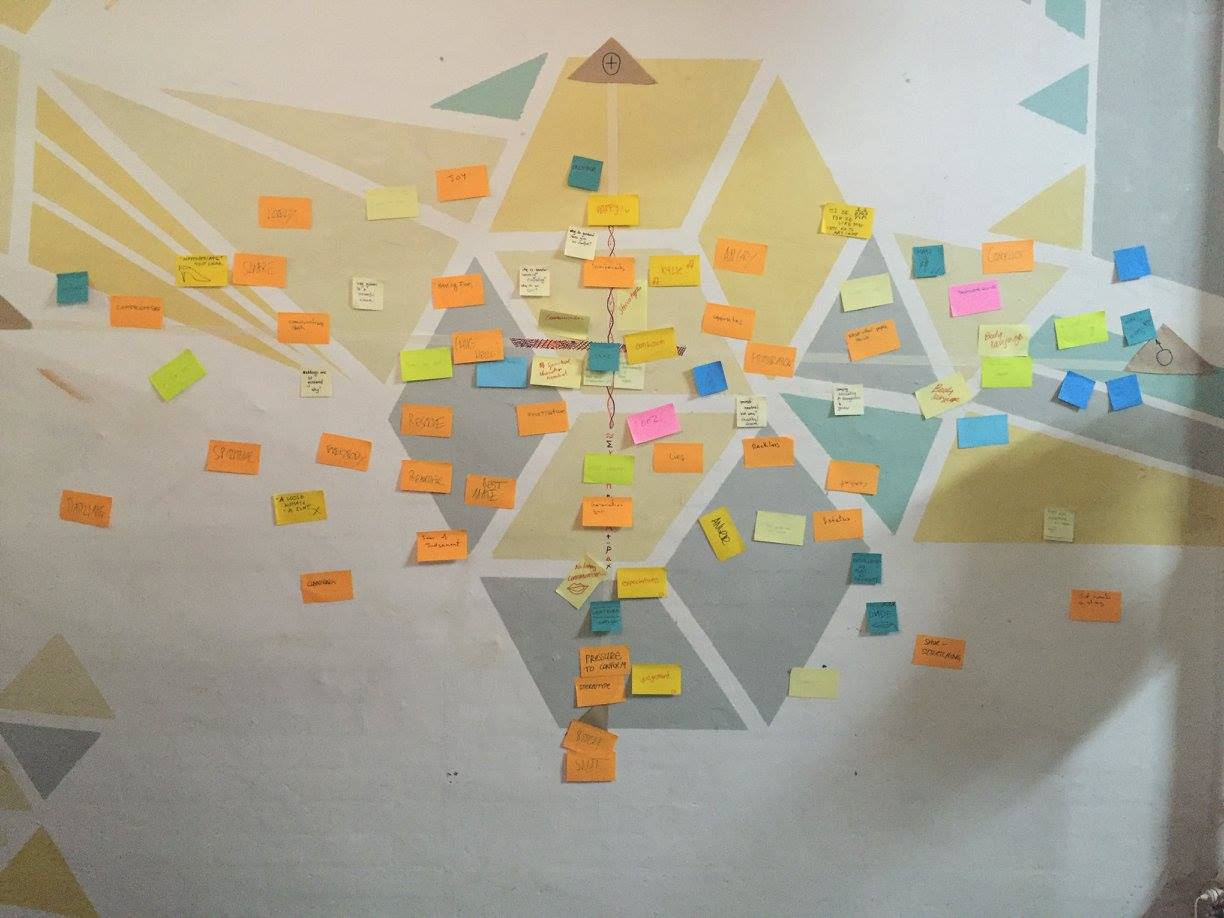 On the wall we had created a matrix, on which we collected these statements to get an overview about feminine and masculine gender ideas in the room. After each performance the whole group would run at the wall and place their triggers and thresholds along a horizontal line that ran from feminine to masculine, and a vertical line that ran from trigger to threshold.
On the wall we had created a matrix, on which we collected these statements to get an overview about feminine and masculine gender ideas in the room. After each performance the whole group would run at the wall and place their triggers and thresholds along a horizontal line that ran from feminine to masculine, and a vertical line that ran from trigger to threshold.
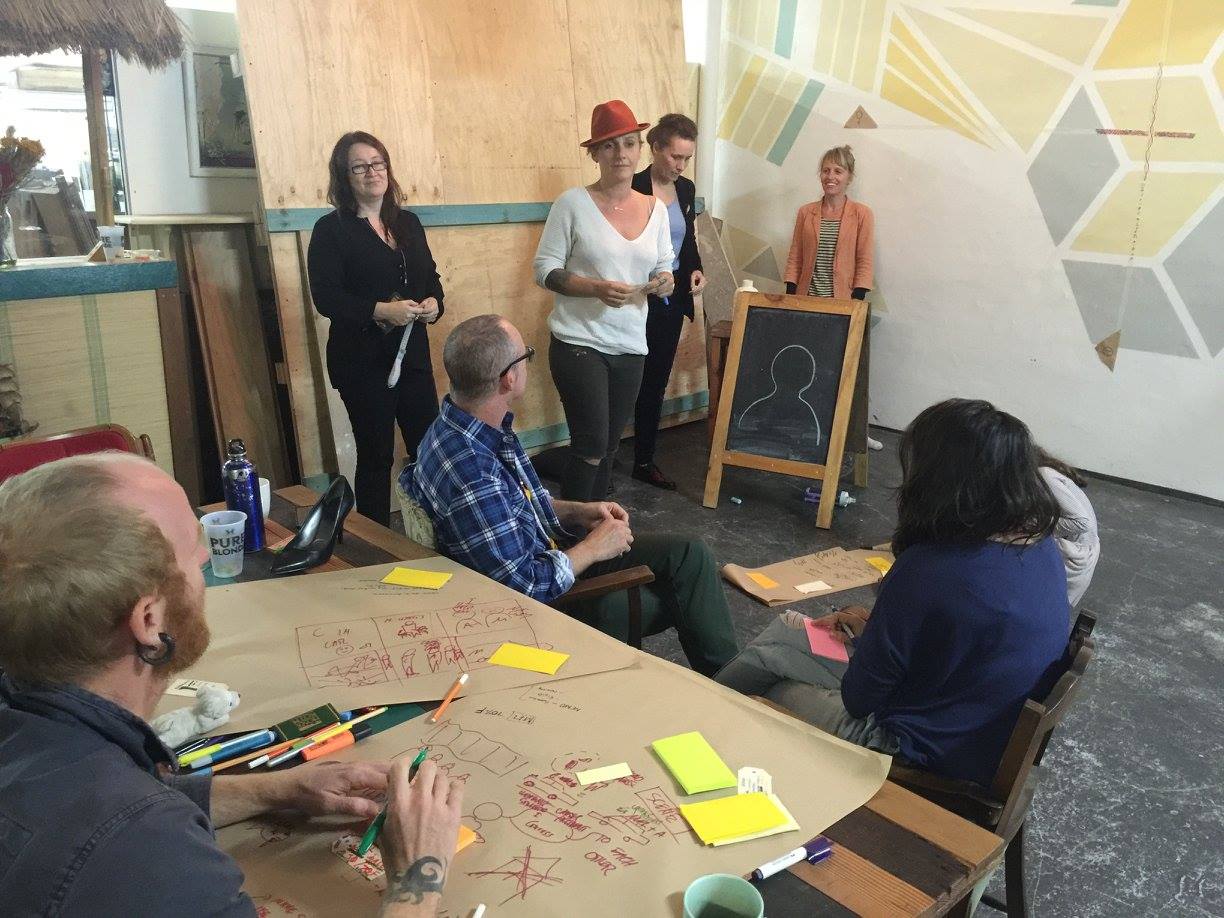 With such a short timeframe there was no more time to drill deeper into areas, such as the “in between”, transgender, orgasms, sexuality, politics, business, language, emancipation of gender, evolution, etc. We left knowing that there was great interest in a series of playgrounds around the topic.
With such a short timeframe there was no more time to drill deeper into areas, such as the “in between”, transgender, orgasms, sexuality, politics, business, language, emancipation of gender, evolution, etc. We left knowing that there was great interest in a series of playgrounds around the topic.
More photos and details are here.
Group size:
Expected size of the group is 15 to 35.
Materials:
Index Cards (6 x 9)
Post-it Notes
Butcher Paper
Masking Tape
Markers (3 different colours)
Room setup
3 tables
2 benches
couches
chairs
floor space and cushions
three walls, one used for projection
